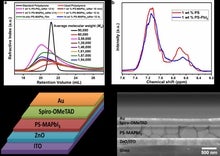Background
Metal halide perovskites possess unique features that make them desirable for solar cell and other electronic device applications. The most commonly studied perovskite absorber is methylammonium lead trihalide family However the instability of organic lead halide perovskites, such as methylammonium lead tri-iodide (MAPbI3), under ambient conditions is a challenge, as it leads to degradation in electronic device performance and has thus limited their long term application.
Description of the invention
Waterloo researchers have developed a perovskite-polymer composite that consists of a cross-linked polymer network integrated with a perovskite film. By way of one example, a precursor mixture of PbI2 (acting as a Lewis acid) with polystyrene (PS) enabled in-situ PS crosslinking arising in a novel perovskite-polymer composite without any encapsulating layer and with a stable structure in ambient conditions after more than 1000 h of continuous 1.0 sun (AM 1.5G) illumination in air (relative humidity of 40–50%) at 45 °C, while also showing a slightly improved device performance. The stability is the result of the direct specific interaction between the polymer and the perovskite that reduces ion migration, charge recombination, trap-state density and dark currents and at the same time leads to improve mobility and carrier life time. The interaction between the polymer and PbI2, also improves the crystallization kinetics leading to larger grain size in the perovskite films. The cumulative effect of these improvements makes the reported polymer-perovskite hybrids well suited for long term device applications.
Advantages
The production method improves the perovskite solar cell stability under normal operating conditions and without requiring any additional encapsulation for significantly greater time compared to other reported methods. This method not only maintains but also improves the efficiency by 1.5-2% for solar cells in a simple one step method using low cost polymer additive. This improved efficiency is significant for photovoltaic applications.
Potential applications
Cost-effective solar cells with high efficiency and simple fabrication, optoelectronic devices based on specific effects in perovskites such as super-capacitors, piezoelectric, ferroelectrics, sensors, energy harvesting devices, catalysis.

Reference
10144
Inventor(s)
Dr. Vivek Maheshwari
Dr. Rohit Saraf
Patent status
PCT/CA2020/050237
Stage of development
Prototype
Contact
Scott Inwood
Director of Commercialization
Waterloo Commercialization Office
519-888-4567, ext. 33728
sinwood@uwaterloo.ca
uwaterloo.ca/research